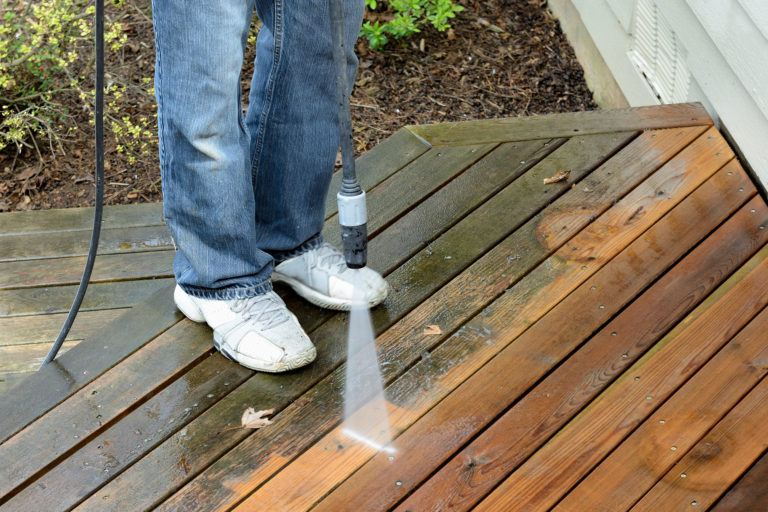
Quick Tips
Your deck goes through a lot—rain, snow, BBQ grease, and more foot traffic than your living room. Over time, dirt, mildew, and stains can turn it into a slippery, weathered mess. If left untreated, a neglected deck can become a safety hazard and even shorten its lifespan. Whether it’s wood, composite, or vinyl, regular deep cleaning keeps your deck looking great and prevents costly repairs.
Why Cleaning Your Deck Matters
A clean deck isn’t just about aesthetics—it’s about safety and durability. Mold, mildew, and algae create slippery surfaces that can lead to accidents, while dirt and moisture accelerate wood rot and decay. Regular cleaning extends the life of your deck, prevents costly repairs, and keeps outdoor spaces inviting year-round.
What You’ll Need to Clean a Deck
Before getting started, gather these supplies:
- Deck cleaner (store-bought or homemade) – Removes dirt, mildew, and stains.
- Garden hose or pressure washer – For rinsing away grime.
- Stiff-bristled brush or deck scrubber – Helps loosen stubborn buildup.
- Bucket – For mixing cleaning solutions.
- Oxygen bleach or white vinegar – A natural alternative to chemical cleaners.
- Baking soda – Helps lift tough stains.
- Broom or leaf blower – Removes surface debris before washing.
- Sealer or stain (optional) – Protects and enhances wood decks after cleaning.
How to Clean a Deck in 7 Steps
1. Clear and Sweep the Deck
Remove all furniture, grills, and planters from the deck. Sweep the surface with a broom or use a leaf blower to remove loose debris, dirt, and leaves. This step prevents grime from being ground into the wood or composite material during scrubbing.
2. Check for Damage and Repair If Needed
Before deep cleaning, inspect the deck for loose boards, popped nails, or signs of rot. Make any necessary repairs, such as securing wobbly railings or replacing damaged planks. If mold or mildew is present, take note of areas that may need extra attention.
3. Choose the Right Cleaning Solution for Your Deck Type
Different decks require different cleaners:
- Wood decks: Use a deck-specific wood cleaner or mix oxygen bleach with water for a natural solution.
- Composite decks: Avoid harsh chemicals and use mild dish soap mixed with water.
- Vinyl or PVC decks: A mix of white vinegar and water removes grime without damaging the surface.
If using a store-bought deck cleaner, follow the manufacturer’s instructions for proper dilution and application.
4. Scrub the Surface with a Stiff Brush
Apply the cleaning solution evenly across the deck using a mop or pump sprayer. Let it sit for 10–15 minutes to break down dirt and mildew. Then, scrub the surface with a stiff-bristled brush or deck scrubber, working in the direction of the wood grain to prevent damage. Pay extra attention to high-traffic areas and stubborn stains.
5. Rinse Thoroughly with a Hose or Pressure Washer
Using a garden hose with a spray nozzle, rinse the deck thoroughly to remove all cleaning solution and loosened debris. If using a pressure washer, keep the pressure below 1,500 PSI for wood decks to avoid damage. Hold the nozzle at least 12 inches from the surface and spray in a sweeping motion.
6. Let the Deck Dry Completely
Allow the deck to air dry for at least 24–48 hours before replacing furniture or applying a sealer. If moisture is trapped, it can lead to mold growth or peeling finishes. Check for any remaining stains that may need a second treatment.
7. Apply a Sealer or Stain for Long-Term Protection (Optional)
If your deck is made of wood, applying a UV-protective sealer or stain helps prevent fading, water damage, and mildew buildup. Use a paintbrush, roller, or sprayer to apply the sealer evenly, following the manufacturer’s drying recommendations. Composite and vinyl decks typically don’t require sealing but can benefit from periodic conditioning treatments.
How Professionals Deep-Clean Decks
If DIY cleaning doesn’t restore your deck’s original look, professionals use advanced techniques such as:
- Commercial-grade pressure washing – Removes deep-set grime without damaging wood fibers.
- Mildew and algae treatments – Specialized solutions prevent regrowth.
- Sanding and refinishing – Restores heavily weathered wood decks.
- Protective coatings – Adds an extra layer of defense against UV damage and moisture.
For severe buildup or restoration projects, a professional deck cleaning service may be the best option (deck maintenance guide).
How Often Should You Clean a Deck?
- Sweep weekly to remove dirt and debris.
- Wash with a mild cleaner every 1–2 months to prevent buildup.
- Deep clean every 6–12 months before resealing or staining.
- Inspect for mold and mildew after heavy rain or humid conditions.
Final Thoughts
A clean deck is a safe, beautiful, and long-lasting outdoor space. Regular maintenance prevents deterioration, enhances curb appeal, and ensures your deck is always ready for entertaining. Whether you’re scrubbing by hand or using a pressure washer, keeping your deck clean means you can enjoy it for years to come.
For more outdoor cleaning tips, check out How to Clean a Patio. Keep your outdoor spaces looking their best!